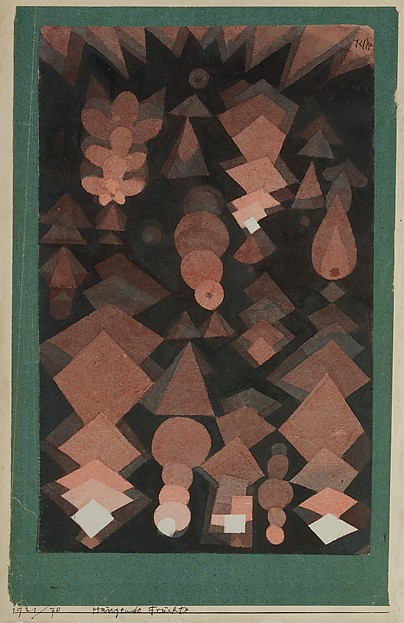Paul Klee (1879-1940) was one of the most renowned artists to work at the Bauhaus and was both a playful and a radical figure in European Modernism. His intense and intricate work is the subject of a major new exhibition at Tate Modern from 16 October 2013, the UK’s first large-scale Klee exhibition for over a decade. Challenging his reputation as a solitary dreamer, it reveals the innovation and rigour with which he created his work and presented it to the public.
Bringing together over 130 colourful drawings, watercolours and paintings from collections around the world, Paul Klee: Making Visible spans the three decades of his career: from his emergence in Munich in the 1910s, through his years of teaching at the Bauhaus in the 1920s, up to his final paintings made in Bern after the outbreak of the Second World War. The show reunites important groups of work which the artist created, catalogued or exhibited together at these key moments in his life. Having since been dispersed across museums and private collections, Tate Modern is showing these delicate works alongside each other once again, often for the first time since Klee did so himself, in a unique chance to explore his innovations and ideas.
Born in Switzerland in 1879, Klee started out as a musician like his parents but soon resolved to study painting in Munich, where he eventually joined Kandinsky’s ‘Blue Rider’ group of avant-garde artists in 1912. Tate Modern’s exhibition begins with his breakthrough during the First World War, when he first developed his individual abstract patchworks of colour.
The many technical innovations that followed are showcased throughout the exhibition, including his unique ‘oil transfer’ paintings like

They’re Biting 1920,
the dynamic colour gradations of

Suspended Fruit 1921
and the multicoloured pointillism used in

Memory of a Bird 1932.
The heart of the exhibition focuses on the decade Klee spent teaching and working at the Bauhaus. The abstract canvases he produced here, such as the rhythmical composition

Fire in the Evening 1929,
took his reputation to new international heights by the end of the 1920s. The 1930s then brought about radical changes, as Klee was dismissed from his new teaching position by the Nazis and took refuge in Switzerland with his family, while his works were removed from collections and labelled ‘degenerate art’ in Germany. Despite the political turmoil, financial insecurity and his declining health, he nevertheless became even more prolific. Tate Modern brings together a group of his final works from the last exhibition staged before his death in 1940.
Although he saw his art as a process of spontaneous creativity and natural growth, exemplified by his famous description of drawing as “taking a line for a walk”, Klee actually worked with great rigour. He inscribed numbers on his works in accordance with a personal cataloguing system and wrote volumes on colour theory and detailed lecture notes. In grouping these works as Klee himself did, this exhibition presents an extraordinary opportunity to explore them in a new light and understand them as the artist intended.
Paul Klee: Making Visible is curated by Matthew Gale, Head of Displays, Tate Modern, with Flavia Frigeri, Assistant Curator, Tate Modern.

The exhibition is accompanied by a fully-illustrated catalogue from Tate Publishing and a programme of talks and events in the gallery.
Nice reviews here and here.
More images from the exhibition:
Paul Klee 1879–1940
Steps 1929
Oil and ink on canvas
520 x 430 mm
Moderna Museet (Stockholm, Sweden)
Paul Klee 1879–1940
Redgreen and Violet-Yellow Rhythms 1920
Lent by The Metropolitan Museum of Art, The Berggruen Klee Collection, 1984 (1984.315.19)
Image © The Metropolitan Museum of Art / Source: Art Resource/Scala Photo Archives
Paul Klee 1879–1940
Static-Dynamic Intensification 1923
Watercolour and transferred printing ink on laid paper with gray and green gouache and black ink mounted on light cardboard
381 x 261 mm
Metropolitan Museum of Art, New York
Paul Klee 1879–1940
Park near Lu 1938
Zentrum Paul Klee
Paul Klee 1879–1940
Fire at Full Moon 1933
Museum Folkwang, Essen, Germany
Paul Klee 1879–1940
Comedy 1921
Watercolour and oil on paper
support: 305 x 454 mm
on paper, unique
Tate. Purchased 1946

Paul Klee 1879–1940 '
Fish Magic' (1925)
Philadelphia Museum of Art/ The Louise and Walter Arensberg Collection